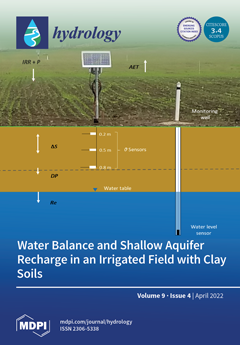Quantifying groundwater recharge from irrigation in water-scarce regions is critical for sustainable water management in an era of decreasing surface water deliveries and increasing reliance on groundwater pumping. Through a water balance approach, our study estimated deep percolation (
DP) and characterized
[...] Read more.
Quantifying groundwater recharge from irrigation in water-scarce regions is critical for sustainable water management in an era of decreasing surface water deliveries and increasing reliance on groundwater pumping. Through a water balance approach, our study estimated deep percolation (
DP) and characterized surface water and groundwater interactions of two flood-irrigated fields in northern New Mexico to evaluate the regional importance of irrigation-related recharge in the context of climate change.
DP was estimated for each irrigation event from precipitation, irrigation input, runoff, change in soil water storage, and evapotranspiration data for both fields. Both fields exhibited positive, statistically significant relationships between
DP and total water applied (TWA), where one field exhibited positive, statistically significant relationships between
DP and groundwater level fluctuation (GWLF) and between GWLF and total water applied. In 2021, total
DP on Field 1 was 739 mm, where 68% of irrigation water applied contributed to
DP. Field 2′s total
DP was 1249 mm, where 81% of irrigation water applied contributed to
DP. Results from this study combined with long-term research indicate that the groundwater recharge and flexible management associated with traditional, community-based irrigation systems are the exact benefits needed for appropriate climate change adaptation.
Full article





